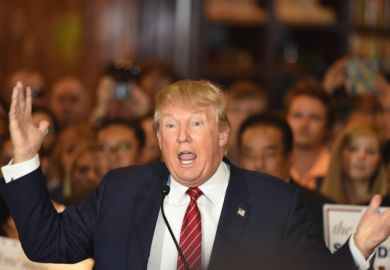If much of the anger that helped boost Donald Trump to his victory in the presidential election is due to globalisation and falling living standards, then higher education may be vital to reversing it.
That was one of the conclusions that could be drawn following a talk by Daniel Greenstein, director of postsecondary success at the Bill & Melinda Gates Foundation, who was speaking at a US conference a few hours after Hillary Clinton conceded the presidential race.
Dr Greenstein told the conference of the Council for Adult and Experiential Learning in Chicago that the election had shown that “the gulf between the haves and have-nots is real and it is getting wider and it is brimming with fear and anger and resentment".
That has occurred as “the bridge to opportunity that is or should be US higher education has become narrower” he said. “It’s harder to navigate. The toll for too many is far too high.”
Unless attention continues to be paid to fixing those problems, he said, they “will leave our economy seriously short of what our economy needs to compete...higher education is something that will contribute to the nation’s success or lack of success”.
More than 95 per cent of jobs created during the US' economic recovery from the global financial crisis have gone to workers with some college education, according to a report from Georgetown University’s Center on Education and the Workforce released earlier this year.
For less-educated workers the recovery “has been virtually nonexistent”, the centre found.
Mr Trump, who famously exclaimed on the campaign trail, “I love the poorly educated”, won among whites who did not go to college by about 40 percentage points, according to exit polls. In the last presidential election, Republican Mitt Romney won 61 per cent of votes from whites without university educations, compared with 36 per cent who voted for Obama, or a difference of 25 percentage points.
Dr Greenstein said he sees possibilities for bipartisan cooperation and progress for higher education under Mr Trump and in a Republican-controlled Congress in areas such as simplifying the form required for students to apply for financial aid.
Mr Trump gave only a few clues during his campaign about his likely higher-education policies.
He has spoken out against regulation, saying it increases costs for students. That could portend a reversal of the Obama administration’s push for more transparency and accountability from colleges and universities that collectively receive nearly $200 billion (£161 billion) a year in taxpayer money in the form of financial aid and research and development funding.
But Trump has also criticised colleges and universities with large endowments for not using more of their own money to ease their costs for students, hinting that he might eliminate their tax-exempt status unless that changes.
Register to continue
Why register?
- Registration is free and only takes a moment
- Once registered, you can read 3 articles a month
- Sign up for our newsletter
Subscribe
Or subscribe for unlimited access to:
- Unlimited access to news, views, insights & reviews
- Digital editions
- Digital access to THE’s university and college rankings analysis
Already registered or a current subscriber?






